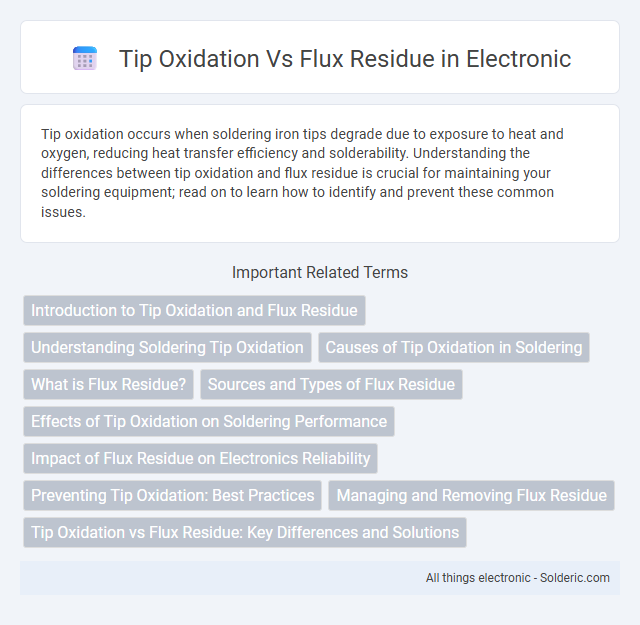Tip oxidation occurs when soldering iron tips degrade due to exposure to heat and oxygen, reducing heat transfer efficiency and solderability. Understanding the differences between tip oxidation and flux residue is crucial for maintaining your soldering equipment; read on to learn how to identify and prevent these common issues.
Comparison Table
| Aspect | Tip Oxidation | Flux Residue |
|---|---|---|
| Definition | Formation of oxide layer on soldering tip due to exposure to air and heat | Residue left by flux after soldering, often sticky or corrosive |
| Cause | Oxidation from oxygen and high temperatures during soldering | Incomplete flux consumption or improper cleaning |
| Appearance | Dull, darkened, or flaky surface on soldering tip | Sticky, crusty, or powdery deposits on PCB or components |
| Impact on Soldering | Reduces heat transfer efficiency, leads to poor solder joints | Causes solder joint contamination, can cause corrosion or short circuits |
| Maintenance | Regular tip cleaning (using tip cleaner or brass sponge) and tinning | Proper post-soldering cleaning using solvents or water-based cleaners |
| Prevention | Keep tip tinned, avoid prolonged exposure to air and heat | Use appropriate flux type and clean residues promptly |
| Effect on Equipment | Shortens soldering tip lifespan if untreated | Can degrade PCB reliability if residue is corrosive |
Introduction to Tip Oxidation and Flux Residue
Tip oxidation occurs when soldering iron tips develop a layer of oxide due to prolonged exposure to heat and air, reducing thermal conductivity and solderability. Flux residue, the leftover substance after soldering, consists of organic or inorganic compounds that can cause corrosion or electrical shorts if not properly cleaned. Understanding the differences between tip oxidation and flux residue is essential for maintaining soldering equipment and ensuring high-quality electronic connections.
Understanding Soldering Tip Oxidation
Soldering tip oxidation occurs when the metal surface reacts with oxygen, creating a layer that inhibits heat transfer and reduces efficiency. Flux residue is a byproduct of soldering flux that can cause corrosion or electrical issues if not properly cleaned. Understanding the difference helps you maintain soldering equipment and ensure reliable connections.
Causes of Tip Oxidation in Soldering
Tip oxidation in soldering occurs primarily due to exposure of the soldering iron tip to high temperatures and ambient oxygen, which causes the formation of an oxide layer that impedes heat transfer. Flux residue, by contrast, is a byproduct of the flux used to prevent oxidation during soldering but can accumulate and degrade tip performance if not cleaned properly. Managing flux residue and maintaining proper tip cleaning routines help minimize oxidation, ensuring your soldering iron tip remains effective and extends its lifespan.
What is Flux Residue?
Flux residue is the leftover material from the flux used during soldering processes, which aids in removing oxides and improving metal wetting. Unlike tip oxidation, which degrades soldering iron tips due to exposure to oxygen, flux residue can remain on the board or component surfaces, potentially causing corrosion or electrical leakage if not properly cleaned. Properly identifying and removing flux residue is crucial for maintaining reliable solder joints and preventing long-term device failures.
Sources and Types of Flux Residue
Flux residue originates primarily from the chemical composition used during soldering, including rosin, activators, and flux solvents that remain after the soldering process. Different types of flux residues include rosin-based, no-clean, and water-soluble fluxes, each leaving distinct residues that vary in corrosiveness and electrical conductivity. Understanding the sources and types of flux residue helps you select appropriate cleaning methods and prevent tip oxidation caused by flux contaminants.
Effects of Tip Oxidation on Soldering Performance
Tip oxidation significantly reduces soldering performance by inhibiting heat transfer and causing inconsistent solder joints. Oxidized tips lead to poor wettability, resulting in weak, unreliable electrical connections that can compromise your electronic assemblies. Regular tip maintenance and cleaning are essential to minimize oxidation and maintain efficient soldering operations.
Impact of Flux Residue on Electronics Reliability
Flux residue can significantly impact electronics reliability by causing corrosion, electrical leakage, and impaired solder joint performance. Unlike tip oxidation, which primarily affects soldering iron efficiency, flux residue remains on circuit boards and creates a conductive path that leads to short circuits and device failure. Ensuring thorough cleaning of flux residue is essential to maintain the long-term durability and functionality of your electronic assemblies.
Preventing Tip Oxidation: Best Practices
Preventing tip oxidation involves regular cleaning through controlled tip reactivation methods such as using brass wire or specialized tip tinner compounds, which remove oxide layers without damaging the soldering iron tip. Applying a thin layer of fresh solder to the tip before and after use creates a protective barrier against oxidation, maintaining optimal heat transfer and extending tip life. Proper storage with the tip coated in solder and using rosin-based fluxes help minimize flux residue buildup, ensuring cleaner joints and consistent soldering performance.
Managing and Removing Flux Residue
Managing and removing flux residue requires precise cleaning methods to prevent corrosion and maintain solder joint integrity. You can use isopropyl alcohol or specialized flux removers to effectively eliminate residue without damaging the PCB or components. Properly handling the residue ensures optimal electrical performance and extends the lifespan of your soldered connections.
Tip Oxidation vs Flux Residue: Key Differences and Solutions
Tip oxidation involves the formation of oxidized layers on soldering iron tips, which impairs heat transfer and solder joint quality. Flux residue, on the other hand, consists of leftover chemicals from the flux used during soldering that can cause corrosion or electrical leakage if not properly cleaned. Preventive measures for tip oxidation include regular tip tinning and proper temperature control, while flux residue requires thorough cleaning with appropriate solvents or no-clean flux formulations to ensure reliable PCB performance.
tip oxidation vs flux residue Infographic

 solderic.com
solderic.com